If you are new to the field, music studios can seem to be all about that fancy equipment and fun lights, but one thing that most people do not give enough attention to is the thing that makes all of the equipment function according to your needs — the audio cables in the studio.
There is no way to really have a well-functioning recording studio without these cables that can otherwise seem to be a very small part of the entire setup.
However, all the different types of cables being used in your studio are not going to be the same in terms of composition or functionality. Then how are you supposed to know which one is the right fit for all the different equipment that it has to be used for? The answer is not too complicated.
You can go through this brief guide to get a better understanding of these audio cables and how they work!
What Is the Difference Between Analog & Digital Signals?
The first step of the process is knowing the two major types of cables that are found in a music studio and getting a better understanding of how information is transmitted through each of these.
To make it easier for you, we have listed the two main types of audio cables below:
- Analog Cables — These cables transmit information with the help of continuous waveforms. This just means that if the information is a 150 Hz sine wave, the voltage running through the cable will be performing 100 positive-negative cycles each second. Such cables are capable of transmitting line, instrument and mic level signals. There are two main types of analog cables — unbalanced and balanced cables — both of which will be discussed in greater detail in the next section.
- Digital Cables — These types of cables transmit information using ‘1’s and ‘0’s, more popularly known as the binary code. As technology advances, the number of — and types of — digital cables are also evolving. This constant state of flux leads to the older forms to be replaced by newer ones, some of which will be discussed later in this guide.
What Is the Difference Between Balanced & Unbalanced Audio Cables?
Analog cables can be either balanced or unbalanced, but what do these terms even mean in this context?
This section will walk you through the basics of both unbalanced and balanced cables so that you can distinguish between them with great ease.
- Unbalanced Cables — These types of cables come with two conductor wires. Out of these, one is a hot wire that will be responsible for carrying the signal, while the other is a common ground wire that is kept connected to an insulated wrap for safety. The main purpose of this second wire is to prevent any interference with the hot lead, which can otherwise cause distortions in the sound. The length of these wires is usually kept shorter than 25 feet, as there is a higher chance of experiencing noise issues beyond that.
- Balanced Cables — In order to prevent, or reduce, the noise problems that can arise with unbalanced cables, the balanced ones come with a second signal conductor. This is usually called a negative or cold conductor. Both the conductors in the cable transmit signals that are identical but 180 degrees out of phase with one another. If the hot wire’s signal voltage increases, the cold wire’s voltage will come down. The noise that is common in both will be out of phase with itself and get eliminated. The common connectors in this context will be discussed in a later section. If you need longer cables, these ones give an impressive, noise-free signal.
Types of Analog Connectors
In a music studio, you usually refer to cables by the type of connectors that they are attached to, and not just the type of cable itself. In this section, we will be looking at the most commonly used analog connectors and be delving deeper into their functionality, so let’s get started!
What are RCA connectors used for?
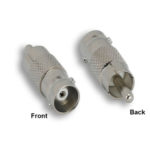
If you have ever tried to connect a DVD player to a TV, you will notice 3 male RCA cables send audio and video signals to the TV.
The RCA or phono connector carries audio and video signals. These connectors can also help transfer both analog and digital signals. They have a central male connector — which looks like a pin that is surrounded by a ring — that needs to be inserted into a female jack — which has a ring encompassing a hole. Both the rings need to touch so that grounding is ensured. This prevents that odd buzzing sound.
What are XLR Connectors?
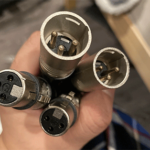
One of the most commonly used connectors for balanced audio cables is an XLR connector. You can find an XLR connection mostly on professional audio, video, and stage lighting equipment.
While it can come with up to 10 pins, it is the 3-pin XLR connectors that you find more easily. These connectors can help transmit a balanced mono signal, which means that if you are looking to transmit a stereo analog signal, two of these cables will be required. An XLR Male is the one that connects to the different hardware inputs, while the XLR Female is the one that connects to the microphone and other hardware outputs. The male ground pin and female connector come in contact first, while makes it possible for you to connect and disconnect an XLR connection in live sound equipment.
What are TS and TRS Connectors?
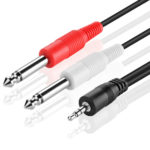
Commonly referred to as a “headphone jack”. A TS connector (tip-sleeve) and a TRS connector (tip-ring-sleeve) are often confused for each other but there is a major difference between the two.
The TS will be commonly used for unbalanced mono signals, while the TRS will be used for balanced mono signals or unbalanced stereo signals.
The extra ring that TRS connectors have is what allows them to transmit balanced signals. For example, the cable that connects your electric guitar to the DI box will be a TS male to TS male cable — in most cases — while the one that connects line outputs from your audio interface to the monitors may be a TRS male to TRS male cable.
What are TT connectors?
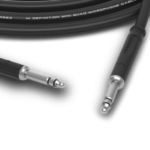
Tiny telephone or TT connectors are basically just mid-sized TS or TRS connectors that come in a shape that is a little different from the regular ones. The most common use of these connectors is for patch bays, as these are relatively more compact and easier to fit. The shape of these TT connectors is also an advantage as the chances of shorting are reduced significantly. An interesting thing to remember is that your home studio patch bay may use a TRS cable but the one in a commercial studio patch bay is more likely to be a TT cable.
Digital Cables
After looking at analog cables and connectors, it is also important to look at the newer and possibly more advanced digital cables in greater detail. As technology evolves, so do the types of digital cables.
For this reason, if one cable is the most commonly used one today, there is a high chance that something better will come around tomorrow and people will switch over to that.
USB Cables
Universal Serial Bus or USB has been the industry standard when it comes to connecting devices like audio interfaces, external hard drives, keyboards and more. It helps these different devices communicate with each other and also get electric power to function. In a USB, one bit of information is transferred at a time by a serial bus, while a parallel bus transfers more data in shorter periods of time with multiple physical connections. USB cables work well for consumer products, as they are thinner and lighter than parallel bus cables. USB cables have also been undergoing constant innovation with changes in connector types and data transfer speeds.
FireWire Cables
Technically, FireWire is the term used by Apple to describe IEEE 1394, the interface standard used by the company for years. These cables are quite similar to USB cables, as these were used to transfer data and electric power as well. There was a time when people preferred this over USB cables because of superior data transferring speeds, but that isn’t the case anymore.
Thunderbolt Cables
Developed by Apple and Intel, Thunderbolt has become the hardware interface standard when it comes to connecting peripherals to a computer. The main reason for this is that the data transfer speed offered by Thunderbolt cables is much higher than that of the USB or FireWire. While the connector — USB Type C connector — is the same as the one found on the latest USB cables, the data is transferred faster with Thunderbolt cables.
Digital Coaxial Cables
These cables — with RCA connectors — are the ones that are used when S/PDIF-formatted digital signals have to be sent between devices. As digital coaxial cables transmit digital and not analog signals, they can transfer two channels of uncompressed PCM audio or compressed 5.1/7.1 surround sound. If you are using a cable to connect your audio interface to an AV receiver, it is probably a digital coaxial cable with RCA connectors.
Fiber Optic Cables
The cables that can be used to send S/PDIF-formatted or ADAT-formatted signals between devices with the help of a series of light pulses are fiber optic cables. Some of the most common uses of these cables are the provision of high-speed data or other telecommunication over long distances. If you are looking to reduce the number of cables in the studio, this is a good option, as it can transmit multiple channels of audio through just one cable.
MIDI Cables
Musical Instrument Digital Interface or MIDI cables are the ones that are often used to connect different instruments, computers as well as audio devices together. These cables are capable of carrying a ton of information about the music — for example, the pitch, velocity, tempo and so on.
Cable Organization
After going through all the different types of cables and connectors that are used — both analog and digital — you may already find yourself a little confused. This confusion is further heightened when it comes to organizing all these cables and wires in a manner that is easy for you to handle.
In order to get more organized, there are some tips and tricks that you must keep in mind when you are dealing with these cables:
- Snake Cables — These cables are great for organization as they allow you to combine many different cables into one. This can help you in keeping all the rack-mounted equipment sorted well. While these cables may not be necessary for smaller studios like bedroom ones, as and when you grow, snake cables become more and more attractive.
- Patch Bays — If you seem to have collected quite a bit of analog equipment, patch bays can work out to be great tools for management of all the cables. These allow you to set up customized signal processing chains without the headache of removing cables from the equipment. All you need to do is connect everything to the back of a patch bay and use the open connector inputs to reroute the audio.
- Cable Winders — This isn’t a suggestion for proper studios but if you have very limited equipment — let’s say about two or three cables — you may want to use cable winders that allow you to take out just the right amount of the cable and send the rest back with a light tug.
- Cutting and Soldering Cables — People with professional studios do not leave any cables exposed on the outside. The main reason for this is that they believe in cutting and soldering their cables on their own. While this can seem complicated for bedroom studio owners, it can be achieved with some practice and the right equipment.
Most equipment that you purchase will already have a set of cables that it will be compatible with, but that isn’t a good enough reason for you to ignore the importance of audio cables and avoid learning more about the different types of cables and connectors that are used with those cables. If you want your audio to be noise-free, you have to know more about the cables being used. Finally, if you want everything to be in place and right where you want it to be, you also need to look out for cable organization!



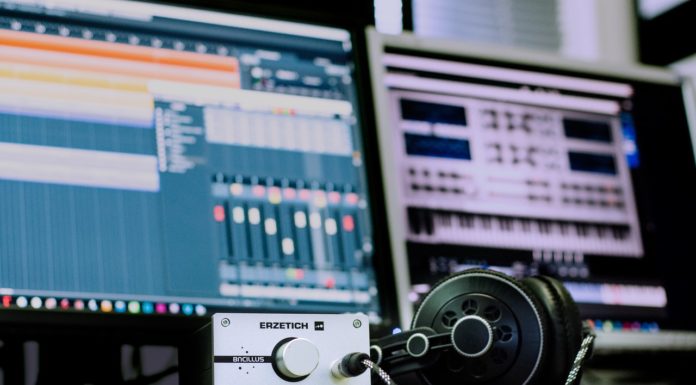



![5 Best 49 Key MIDI Controllers 2022 [Reviews & Buyer’s Guide] best 49key midi keyboards](https://homestudiohub.com/wp-content/uploads/2020/03/best-49key-midi-keyboards-80x60.jpg)



